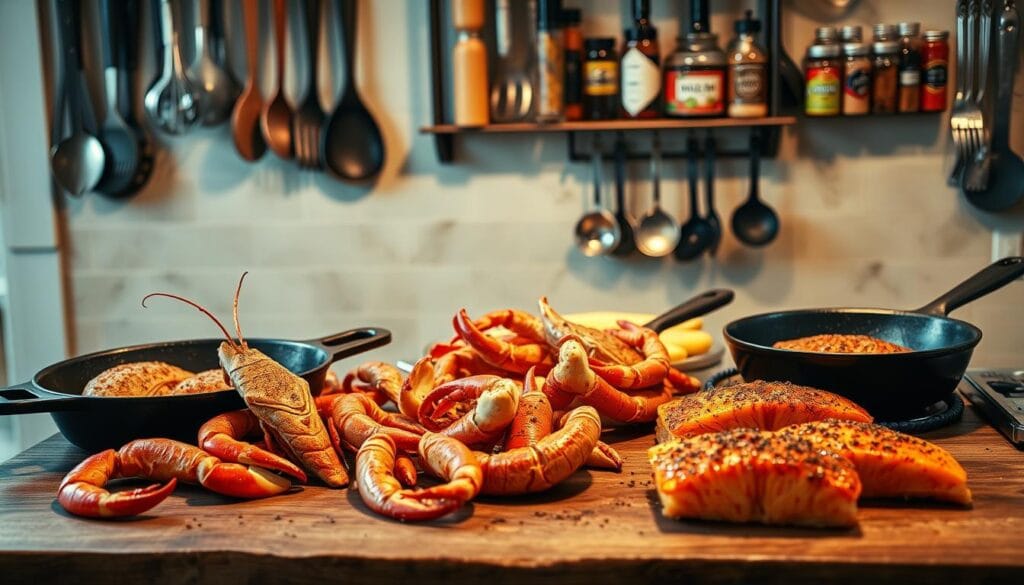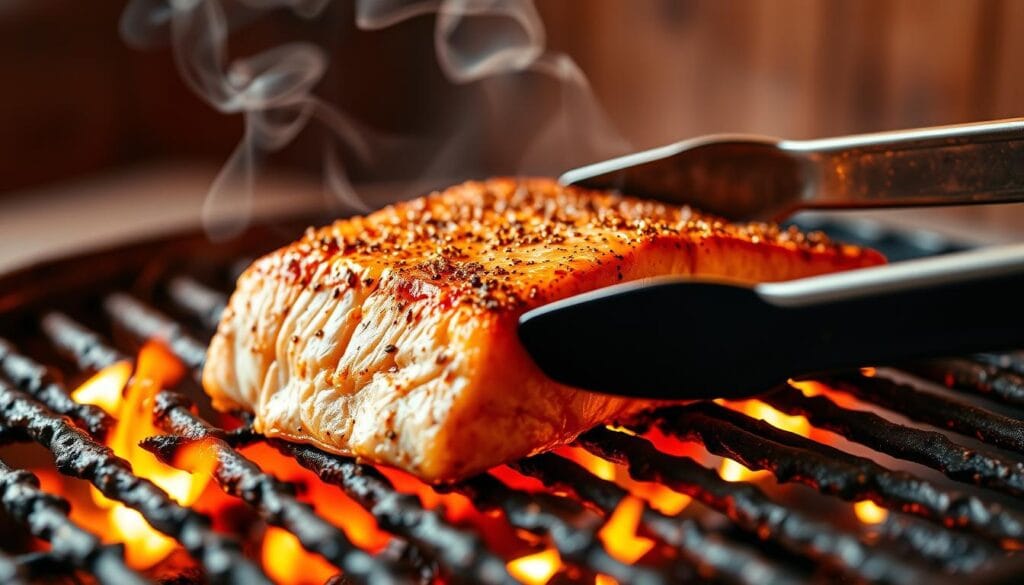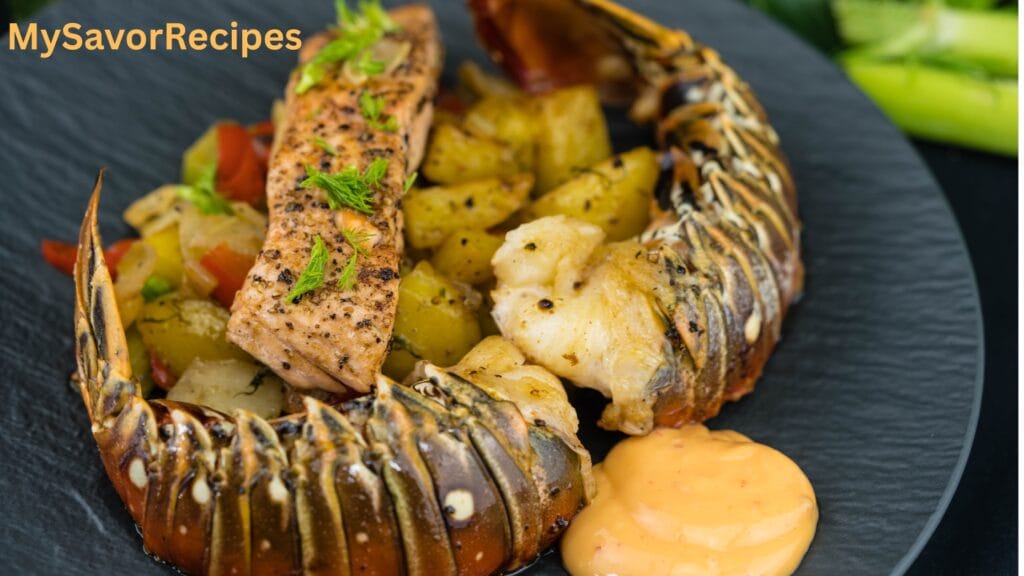Growing up in Louisiana, I learned the magic of Cajun seafood early. My grandmother’s first Cajun lobster from her cast-iron pot was unforgettable. The rich, spicy smells weren’t just cooking. They were making memories.
A Cajun seafood feast is more than a meal. It’s an experience that turns simple ingredients into culinary art. Whether you’re a seasoned cook or just starting, learning Cajun lobster, crab, and salmon techniques will improve your cooking. It will also take your taste buds to Louisiana’s heart.
This guide will teach you everything about making Cajun seafood like a pro in your kitchen. You’ll learn about choosing the best ingredients and traditional cooking methods. You’ll discover how to make a seafood experience that’s both real and unforgettable.
Table of Contents
Key Takeaways
- Discover authentic Cajun seafood preparation techniques
- Learn how to select premium seafood ingredients
- Understand the essential spices and seasonings
- Master temperature control for perfect seafood
- Create restaurant-quality dishes at home
Understanding the Art of Cajun Seafood Preparation
Dive into the vibrant world of Cajun seafood. Here, flavor meets tradition in every delicious bite. Crafting an authentic Cajun Seafood Boil is more than just ingredients. It’s about understanding the rich culinary heritage that turns simple seafood into an extraordinary feast.
Exploring the nuanced art of Cajun cooking opens up a universe of taste and technique. This will elevate your gourmet seafood online experience.
Essential Cajun Seasonings and Spices
The heart of Cajun cuisine lies in its bold spice blend. Your pantry should be stocked with key ingredients that create the signature kick:
- Cayenne pepper for heat
- Paprika for depth
- Garlic powder for richness
- Onion powder for complexity
- File powder for authentic Louisiana flavor
Traditional Cooking Methods
Cajun seafood preparation isn’t just cooking—it’s an art form. Master these traditional techniques to bring authentic flavors to your kitchen:
| Cooking Method | Characteristic | Best Seafood |
|---|---|---|
| Boiling | Intense flavor infusion | Crab, Shrimp |
| Blackening | Crispy spiced exterior | Fish, Salmon |
| Grilling | Smoky char | Lobster, Seafood Skewers |
Equipment You’ll Need
Transforming your kitchen into a Cajun seafood paradise requires some specialized tools:
- Large boiling pot
- Seafood crackers
- Sturdy strainer
- Heavy-duty gloves
- Outdoor propane burner
Whether you’re ordering gourmet seafood online or shopping locally, these tools will help you create an authentic Cajun Seafood Boil. This will impress even the most discerning seafood lovers.
Selecting Premium Lobster Tail for Your Cajun Feast
Choosing the perfect lobster tail can make your Cajun seafood feast unforgettable. When picking lobster tail, several important factors affect its quality and taste.
With Fresh Seafood Delivery, you can get high-quality lobster tails right at home. Here are the key things to look for in lobster tail quality:
- Vibrant, translucent white or light pink coloration
- Firm, smooth texture without discoloration
- Mild oceanic scent, free from strong fishy odors
- Intact shell with no visible cracks or damage
Different lobster tails have their own flavors. Cold-water lobster tails from places like Maine are sweeter and more delicate. Chefs say cold-water lobster tails are best for fine Cajun dishes.
When buying lobster tail, keep these tips in mind:
- Verify sustainable fishing practices
- Check for reputable Fresh Seafood Delivery services
- Inspect packaging and shipping conditions
- Confirm proper temperature during transit
The size of the lobster tail is also important. Medium-sized tails (4-6 ounces) are perfect for Cajun cooking. They have great meat quality and cooking consistency.
Pro tip: Always purchase lobster tail from trusted seafood vendors who prioritize quality and freshness.
Mastering Cajun Lobster, Crab, and Salmon Cooking Techniques
Cooking seafood needs precision and skill. Whether it’s Cajun Lobster, Crab Legs, or Salmon Fillet, knowing the right techniques makes your kitchen feel like a gourmet seafood restaurant.

Seafood cooking is an art that requires attention to detail and careful preparation. Professional chefs know that mastering specific cooking methods makes a big difference between a good and exceptional dish.
Perfect Temperature Control
Temperature is key to cooking seafood perfectly. Each type of seafood needs a unique heat approach:
- Cajun Lobster: Cook at 350°F for optimal tenderness
- Crab Legs: Steam at 325°F to keep them moist
- Salmon Fillet: Bake around 375°F for a flaky texture
Timing Your Seafood
Getting the timing right prevents overcooking, which can make seafood tough. Here are some guidelines:
- Lobster Tails: 1 minute per ounce
- Crab Legs: 4-5 minutes if pre-cooked
- Salmon Fillets: 10-12 minutes for medium doneness
Sauce Pairing Guidelines
Enhance your seafood with Cajun-inspired sauces. Spicy remoulade pairs well with Cajun Lobster. A zesty citrus butter is great for Crab Legs and Salmon Fillets.
Pro tip: Always let seafood rest for 2-3 minutes after cooking to retain juices and maximize flavor.
Expert Tips for Preparing Succulent Crab Legs
Crab legs are a delicious centerpiece for any seafood platter. They offer a luxurious seafood experience that can make your meal special. It’s important to choose the right type of crab legs for a memorable meal. Snow crab and king crab each add unique flavors and textures.
Preparing crab legs needs careful attention to cooking techniques. Follow these expert tips for tender, delicious results:
- Choose fresh or properly thawed crab legs
- Select cooking method based on desired texture
- Use minimal seasoning to preserve natural flavors
- Avoid overcooking to maintain meat’s delicate texture
Different cooking methods can change how your crab legs taste:
| Cooking Method | Cooking Time | Flavor Profile |
|---|---|---|
| Boiling | 4-5 minutes | Classic, traditional taste |
| Steaming | 5-6 minutes | Moist, delicate flavor |
| Grilling | 3-4 minutes | Smoky, rich undertones |
When serving crab legs, how you present them matters. Crack the shells carefully to show the meat inside. Serve with melted butter, lemon wedges, and your favorite sauces for a better dining experience.
“The secret to perfect crab legs is respecting the natural flavor of the seafood.” – Culinary Expert
Pro tip: Always buy crab legs from trusted seafood markets for freshness and quality. Your careful preparation will make a dish that impresses seafood lovers.
Creating the Ultimate Cajun Seafood Boil
A Cajun Seafood Boil turns a simple meal into a grand feast. It brings people together, celebrating Louisiana’s rich culinary heritage. This method makes dining vibrant, flavorful, and communal.
Prepare for a delicious journey that will excite your taste buds. It’s a chance to make unforgettable memories with loved ones.
Essential Ingredients for Your Boil
- Fresh seafood (shrimp, crab, crawfish, or lobster)
- Red potatoes
- Corn on the cob
- Andouille sausage
- Cajun seasoning blend
- Garlic
- Lemon wedges
Step-by-Step Boiling Process
- Fill a large pot with water and seasonings
- Bring water to a rolling boil
- Add potatoes and cook for 10 minutes
- Add corn and sausage
- Add seafood last to prevent overcooking
- Drain and spread on a large serving platter
Serving Suggestions
The essence of a Cajun Seafood Boil lies in its presentation. Spread the boiled ingredients on a table covered with newspaper. Let everyone enjoy it family-style. Offer napkins, crackers, and melted butter for dipping.
“A true Cajun Seafood Boil isn’t just a meal, it’s a celebration of flavor and community.” – Louisiana Culinary Tradition
Pro tip: Serve your Cajun Seafood Boil with cold beer or white wine. It’s the perfect touch for a summer gathering.
Grilling Perfect Salmon Fillets with Cajun Flair

Turning your salmon fillet into a Cajun dish is all about precision and passion. When you buy premium salmon from gourmet seafood online, you’re ready for a great meal. The secret to a delicious Cajun salmon is using top-notch ingredients and learning how to grill.
Begin with fresh, wild-caught salmon fillets. They should be bright in color and firm. Your Cajun seasoning mix is key. It should include:
- Paprika
- Cayenne pepper
- Garlic powder
- Dried oregano
- Black pepper
Getting your salmon ready is important. Dry the fish, then cover it with your spice mix. Heat your grill to medium-high. Make sure the grates are clean and a bit oily to avoid sticking.
How you grill is crucial. Cook the salmon for 4-5 minutes on each side, depending on its thickness. You want a crispy outside and a soft inside. Pro tip: Use a fish spatula for easy flipping and minimal breakage.
Online gourmet seafood stores often have great salmon for Cajun cooking. By following these steps, you’ll make a dish that rivals a restaurant’s.
Crafting Signature Cajun Seafood Platters
Making a Shellfish Platter can turn a regular meal into a memorable Seafood Feast. Your presentation can make the meal go from simple to spectacular. It will impress everyone and excite their taste buds with your skill.
Creating a seafood platter needs careful planning and creativity. You want to make a display that shows off the fresh seafood’s colors and textures.
Platter Composition Strategies
When making your Shellfish Platter, keep these tips in mind:
- Variety of seafood selections
- Color contrast between ingredients
- Balanced protein distribution
- Complementary flavor profiles
Garnishing Techniques
Enhance your Seafood Feast with these garnishing tips:
- Use fresh herbs like parsley and dill
- Add citrus wedges for brightness
- Incorporate edible flowers
- Sprinkle microgreens for elegance
Presentation Tips
Visual appeal is key, as chefs know. Arrange seafood in circular or cascading patterns. This makes each piece visible and appealing. Use large, white platters to highlight colors and create contrast.
A stunning Shellfish Platter is art you can eat!
Storage and Reheating Guidelines for Leftover Seafood
Keeping your gourmet seafood fresh requires careful storage and reheating. Seafood is delicate and can lose its flavor and texture quickly if not stored right.
Here are the key steps for storing leftover seafood:
- Refrigerate seafood within two hours of cooking
- Store in airtight containers
- Keep refrigerated at 40°F or below
- Consume within 1-2 days for optimal freshness
Freezing seafood can also help keep it fresh longer. Follow these freezing tips:
| Seafood Type | Refrigerator Storage | Freezer Storage |
|---|---|---|
| Cooked Lobster | 1-2 days | 2-3 months |
| Crab Legs | 1-2 days | 2-3 months |
| Salmon | 1-2 days | 2-3 months |
When reheating seafood, use gentle methods to avoid overcooking. Low and slow helps keep moisture and flavor. Here are some good ways to reheat:
- Steaming for 3-5 minutes
- Oven heating at 275°F wrapped in foil
- Microwave with a damp paper towel for short intervals
Make sure the seafood reaches 145°F to ensure it’s safe to eat when reheating.
Conclusion
You’ve now explored the vibrant world of Cajun seafood preparation. Your kitchen is now a flavor-packed destination for Cajun Lobster, Crab Legs, and Salmon Fillet dishes. The techniques and insights shared empower you to create restaurant-quality seafood meals.
Mastering Cajun cooking is about embracing bold flavors and precise cooking methods. Whether you’re grilling a perfectly seasoned salmon fillet or preparing a sumptuous seafood boil, your skills will impress. Remember, practice and passion are key to developing your seafood cooking expertise.
The journey doesn’t end here. Keep experimenting with different Cajun seafood recipes and new spice combinations. Sustainable seafood sourcing and careful preparation will ensure delicious results every time. Your commitment to learning and passion for flavor will make each Cajun seafood experience memorable.
Invite friends and family to share in your seafood feast. Create lasting memories around a table filled with delectable Cajun-style dishes. Your cooking skills are now a gateway to experiencing the rich, vibrant culinary traditions of Louisiana right in your own home.

